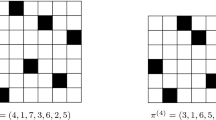Abstract
The number of peaks of a random permutation is known to be asymptotically normal. We give a new proof of this and prove a central limit theorem for the distribution of peaks in a fixed conjugacy class of the symmetric group. Our technique is to apply analytic combinatorics to study a complicated but exact generating function for peaks in a given conjugacy class.

Similar content being viewed by others
References
Bayer, D. and Diaconis, P., Trailing the dovetail shuffle to its lair, Ann. Appl. Probab. 2 (1992), 294–313.
Billey, S., Burdzy, K. and Sagan, B., Permutations with given peak set, J. Integer Seq. 16 (2013), Article 13.6.1.
David, F. and Barton, D., Combinatorial chance, Hafner Publishing Co., 1962.
Diaconis, P., Group representations in probability and statistics, Institute of Mathematical Statistics, Hayward, CA, 1988.
Diaconis, P., Fulman, J. and Holmes, S., Analysis of casino shelf shuffling machines, Annals Appl. Probab. 23 (2013), 1692–1720.
Diaconis, P. and Graham, R., Magical mathematics. The mathematical ideas that animate great magic tricks, Princeton University Press, 2012.
Diaconis, P., McGrath, M. and Pitman, J., Riffle shuffles, cycles, and descents, Combinatorica 15 (1995), 11–29.
Fulman, J., Stein’s method and non-reversible Markov chains, in: Stein’s method: expository lectures and applications, 69-77, IMS Lecture Notes Monogr. Ser., 46, Inst. Math. Statist., 2004.
Fulman, J., The distribution of descents in fixed conjugacy classes of the symmetric groups, J. Combin. Theory Ser. A 84 (1998), 171–180.
Fulman, J., Neumann, P. and Praeger, C., A generating function approach to the enumeration of matrices in classical groups over finite fields, Mem. Amer. Math. Soc. 176 (2005), no. 830.
Gessel, I. and Reutenauer, C., Counting permutations with given cycle structure and descent set, J. Combin. Theory Ser. A 64 (1993), 189–215.
Graham, R.L., Knuth, D.E., Patashnik, O., Concrete mathematics: a foundation for computer science, 2nd ed. Addison-Wesley, Reading, Mass. (1994).
Harper, L., Stirling behavior is asymptotically normal, Ann. Math. Stat. 38 (1966), 410–414.
Kim, G., Distribution of descents in matchings, Annals Combin. 23 (2019), 73–87.
Kim, G. and Lee, S., Central limit theorems for descents in conjugacy classes of \(S_n\), J. Combin. Theory Ser. A 169 (2020), 105123,
Knuth, D., The art of computer programming, Volume 3. Sorting and searching, Addison-Wesley, 1973.
Nyman, K., The peak algebra of the symmetric group, J. Algebraic Combin. 17 (2003), 309–322.
Petersen, K., Eulerian numbers, Birkhauser, 2015.
Petersen, K., Enriched \(P\)-partitions and peak algebras, Adv. Math. 209 (2007), 561–610.
Pitman, J., Probabilistic bounds on the coefficients of polynomials with only real zeros, J. Combin. Theory Ser. A 77 (1997), 279–303.
Reiner, V., Signed permutation statistics and cycle type, Europ. J. Combin. 14 (1993), 569–579.
Robbins, H. “A Remark on Stirling’s Formula.” The American Mathematical Monthly 62, no. 1 (1955), 26–29.
Schocker, M., The peak algebra of the symmetric group revisited, Adv. Math. 192 (2005), 259–309.
Stembridge, J., Enriched \(P\)-partitions, Trans. Amer. Math. Soc. 349 (1997), 763–788.
Tanny, S., A probabilistic interpretation of Eulerian numbers, Duke Math. J. 40 (1973), 717–722.
Vershynin, R., High-Dimensional Probability. Cambridge University Press, 2018.
Warren, D. and Seneta, E., Peaks and Eulerian numbers in a random sequence, J. Appl. Probab. 33 (1996), 101–114.
Acknowledgements
We are very grateful to two referees for many detailed comments. Fulman was supported by Simons Foundation Grant 400528.
Author information
Authors and Affiliations
Corresponding author
Additional information
Publisher's Note
Springer Nature remains neutral with regard to jurisdictional claims in published maps and institutional affiliations.
Rights and permissions
About this article
Cite this article
Fulman, J., Kim, G.B. & Lee, S. Central Limit Theorem for Peaks of a Random Permutation in a Fixed Conjugacy Class of \(S_n\). Ann. Comb. 26, 97–123 (2022). https://doi.org/10.1007/s00026-021-00561-4
Received:
Accepted:
Published:
Issue Date:
DOI: https://doi.org/10.1007/s00026-021-00561-4



